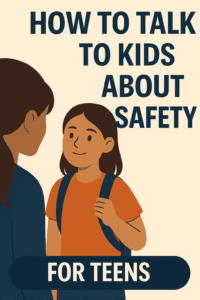How to Talk to Teens (Ages 14–18) About Safety: Preparing for Real-World Independence
The teenage years are full of milestones: first jobs, driving, dating, sports, social events, and eventually preparing for life after high school. With new freedoms come new risks — and teens, wired for independence and risk-taking, often underestimate danger.
This makes ages 14–18 a critical stage for safety conversations. At The Security Playbook, Coach Cover is here to guide parents through trauma-informed, psychologically sound strategies for helping teens navigate real-world safety with confidence.
Why Safety Conversations Are Crucial in High School
-
Increased independence. Teens drive, date, and work jobs where parents aren’t present.
-
Peer influence is intense. Friend groups and social standing often outweigh parental advice.
-
Real-world risks rise. Vehicle accidents, substance use, online exploitation, and unsafe relationships are common threats.
-
Life transitions loom. High school is preparation for adulthood — the last window to reinforce safety foundations.
Psychological Principles for Ages 14–18
-
Risk-taking is normal. Teen brains crave novelty and reward, making impulsive choices more likely.
-
Respect is non-negotiable. Teens shut down if they feel patronized. Conversations must treat them as partners.
-
Identity matters. Teens define themselves through independence; framing safety as part of maturity works best.
-
Peer judgment is powerful. Giving them face-saving strategies to stay safe helps them balance social pressures.
Trauma-Informed Approach:
-
Avoid scare tactics. Focus on facts and empowerment.
-
Keep conversations collaborative. Ask questions instead of issuing commands.
-
Validate their perspective while reinforcing non-negotiable boundaries.
Key Safety Topics for Ages 14–18
1. Driving Safety
Car accidents are the #1 risk for teens.
-
Emphasize no texting while driving.
-
Always buckle seatbelts — passengers included.
-
Discuss curfews, weather conditions, and distracted driving.
Pro Tip: Use apps that limit texting while driving.
Scenario: Your teen gets a text while driving. Instead of reacting impulsively, they know to pull over or wait until they’re home.
2. Dating & Consent
Teens enter relationships where emotional and physical safety matter.
-
Teach the basics of consent: “Yes means yes. Anything else means stop.”
-
Encourage healthy boundaries and respect.
-
Discuss warning signs of controlling or unsafe partners.
Pro Tip: Use media (TV, news stories) as entry points for these conversations.
3. Substance Use & Peer Influence
-
Talk about the realities of alcohol, drugs, and vaping.
-
Frame it as health and safety, not just punishment.
-
Encourage an “out” plan — a code word to text if they need a safe ride home.
Scenario: At a party, your teen sees peers using substances. Instead of feeling trapped, they know they can call you — no questions asked in the moment.
4. Online Reputation & Digital Safety
-
Teach that online posts last forever.
-
Discuss sexting risks and digital exploitation.
-
Emphasize protecting personal info.
Pro Tip: Remind them: “Before you post, ask — would I be okay with this on a billboard?”
5. Situational Awareness in Public Spaces
-
Teach basics: identify exits, stay alert, travel with friends.
-
Reinforce trusting instincts — if something feels wrong, leave.
-
Encourage safe ridesharing practices (check license plate, sit in back).
6. School & Job Safety
Teens balance school, sports, and part-time jobs.
-
Encourage them to report unsafe situations at work or school.
-
Teach worker rights for safety and harassment.
-
Discuss how to handle emergencies like lockdowns calmly.
How to Talk to Teens About Safety
-
Respect their maturity. Speak to them like young adults.
-
Share responsibility. Frame rules as mutual agreements, not commands.
-
Use real-world examples. Stories resonate more than statistics.
-
Balance freedom with guardrails. Grant independence alongside accountability.
Sample Conversation Starters
-
“If you’re ever in a car and the driver is unsafe, what could you do?”
-
“What do you think consent means in a relationship?”
-
“What’s your plan if you’re at a party and don’t feel comfortable?”
-
“How can you spot if someone online isn’t who they say they are?”
Common Mistakes Parents Make
❌ Lecturing instead of listening.
❌ Using scare tactics that push teens away.
❌ Assuming “my teen knows better” — without reinforcement, risky behavior can still win.
❌ Ignoring online risks because “they’re smart with tech.”
FAQs for Parents of Teens
Q: Should I track my teen with apps?
👉 Transparency is key. Tracking can be helpful, but involve them in the decision. Make it about safety, not spying.
Q: How do I know when to give more freedom?
👉 Base it on responsibility shown. Gradual increases in independence are better than sudden leaps.
Q: How do I talk about consent without making it awkward?
👉 Keep it straightforward: respect, boundaries, and listening matter. Use media as springboards.
Q: My teen takes risks despite rules — what do I do?
👉 Keep the dialogue open. Reinforce consequences calmly, but focus on building trust so they come to you next time.
Wrapping It Up: Safety as Real-World Readiness
The teenage years are about preparation — for college, work, and life on their own. By talking openly about driving, relationships, substances, and situational awareness, you’re not just keeping them safe now — you’re preparing them for adulthood.
Your role isn’t to control every move but to equip them with skills and confidence to navigate risks independently.
👉 Next Step: Review your family’s safety plan together and try our FREE Home Security Score Assessment to make safety part of their journey into independence.
Stay safe, stay proactive.
— Coach Cover & The Security Playbook

